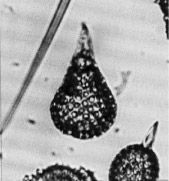 Eusyringium
lagena (Ehrenberg)
Eusyringium
lagena (Ehrenberg) Eusyringium
lagena (Ehrenberg)
Eusyringium
lagena (Ehrenberg)Lithopera lagena Ehrenberg, 1873, p.241; 1875, pl.3, fig.4
Eusyringium lagena (Ehrenberg), Riedel and Sanfilippo, 1970, p.527, pl.8, figs.5-7; Foreman, 1973, p.436, pl.11, figs.4-5
Cephalis subspherical, with few small pores, bearing a stout conical horn. Thorax pyriform with no appendages, thick wall, subcircular pores, and very constricted mouth. Some late specimens have an abdomen in the form of a narrow tube with very thin wall and irregular pores (commonly elongated longitudinally) (Riedel and Sanfilippo, 1970).
The cephalis and thorax together are 100-145 µm long, and the thorax is 70-125 µm wide.
Shell pyriform, with a stout conical horn approximately as broad as the cephalis. The inflated thorax is not prolonged as a narrow tube (Riedel and Sanfilippo, 1978a).
The consistent recognition of this form is rendered difficult by its very simple structure, and by the co-occurrence of several rather similar species. Specimens are admitted to Eusyringium lagena only if feet are completely lacking, the thorax is pyriform rather than ovate, and the aperture is no wider than about one-sixth of the maximum thoracic breadth. The most reliable identifications can be made in a stratigraphic sequence, where it is possible to follow its development from the Sethochytris babylonis (Clark and Campbell, 1942) group Riedel and Sanfilippo (1970) through atrophy of the feet. The commonest of the co-occurring forms with which Eusyringium lagena may be confused are an ovate form with a relatively wider aperture, and horn absent or weak, and a rounded-conical form with short, three-bladed feet and thoracic pores in longitudinal rows (Sanfilippo et al., 1985).
Through its short stratigraphic range, E. lagena exhibits only slight variability in the stoutness of the horn and breadth and length of the thorax, the latter having a tendency to become more elongate toward the end of the range. In addition, near the evolutionary transition to E. fistuligerum, a narrow terminal tube with a very thin wall is present. In some specimens, the thorax bears one or occasionally more wings proximally (Sanfilippo et al., 1985).
The morphotypic first appearance of this species defines the base of the Thyrsocyrtis triacantha Zone. Its morphotypic last appearance lies within the Podocyrtis mitra Zone.
Although this form is found in tropical assemblages of middle middle Eocene age, in the Indian Ocean it is very rare in the early part of its range, and therefore the base of the Thyrsocyrtis triacantha Zone might more conveniently be approximated there on the basis of the evolutionary transition from Thyrsocyrtis tensa to T. triacantha.
This species evolved from the Sethochytris babylonis group and into Eusyringium fistuligerum.